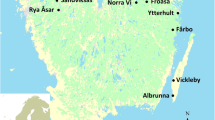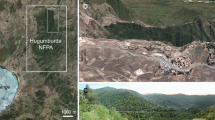Abstract
Permanent vegetation plots established in 1968 at the Baskett Research and Education Area (BREA) were remeasured in 2004/2005 to assess trends in canopy composition, vegetation–environment relationships, and regeneration patterns. Quercus spp. [particularly Quercus alba (white oak)] remained dominant in BREA forests. However, Nonmetric Multidimensional Scaling Ordination of a dataset composed of tree importance values from both samples indicated the two most common community types (Dry Ridge and Slope; Mesic Slope) were shifted away from Quercus spp. abundance toward greater importance of Acer saccharum (sugar maple) in ordination space. Plots in glade-like environments shifted toward greater Juniperus virginiana (eastern redcedar) importance. Environmental analysis indicated that soil properties (pH, organic matter, Ca, Mg, and K) and slope position were highly correlated with ordination axes. Saplings of Quercus spp. exhibited greatly reduced abundance in the most recent sample and the reduction in Quercus spp. density was highest in plots with greatest canopy cover. While Acer saccharum saplings were still quite abundant in BREA forests, smaller sapling size classes were becoming notably depleted, reflecting growth of a cohort of plants established before the 1968 sample toward and into tree-sized individuals. Seedlings surveys emphasized that A. saccharum seedlings have become very rare in BREA forests, while Quercus spp. seedling densities are higher, but likely below those needed for eventual adequate recruitment to the canopy. Although a number of mechanisms to explain apparent A. saccharum regeneration failure can be developed, herbivory, recent climate trends (warming late-winter conditions) and increased litter layer depth are the most plausible explanations for the observed scarcity of A. saccharum seedlings. Although increasing importance of A. saccharum in the canopy of BREA forests appears inevitable in coming decades, longer-term trends are unclear given the shortage of seedling regeneration.



Similar content being viewed by others
References
Abrahamson WG, Gohn AC (2004) Classification and successional changes of mixed-oak forests at Mohn Mill Area, Pennsylvania. Castanea 69:194–206. doi:10.2179/0008-7475(2004)069<0194:CASCOM>2.0.CO;2
Abrams MD (1992) Fire and the development of oak forests. Bioscience 42:346–353. doi:10.2307/1311781
Abrams MD (2003) Where have all the white oaks gone? Bioscience 53:927–939. doi:10.1641/0006-3568(2003)053[0927:WHATWO]2.0.CO;2
Abrams MD (2005) Prescribing fire in eastern oak forests: is time running out? North J Appl For 22:190–196
Aldrich PR, Parker GR, Romero-Severson J, Michler CH (2005) Confirmation of oak recruitment failure in Indiana old-growth forest: 75 years of data. For Sci 51:406–416
Bahari ZA, Pallardy SG, Parker WC (1985) Photosynthesis, water relations and drought adaptation in six woody species of oak-hickory forests in central Missouri. For Sci 31:557–569
Bell DT (1997) Eighteen years of change in an Illinois streamside deciduous forest. Bull Torrey Bot Club 124:174–188
Bennitt R, Nagel WO (1937) A survey of the resident game and furbearers of Missouri. University of Missouri studies, vol. XII(2). University of Missouri, Columbia, MO, pp 92–99
Beringer J, Hansen LP (2009) Missouri whitetails: a management guide for landowners and deer enthusiasts. Missouri Dept Conserv http://mdc.mo.gov/nathis/mammals/deer/index.htm. Accessed 12 Jan 2009
Bonner FT (tech. coord.), Nisley RT (managing ed.) (2003) Woody plant seed manual. Agric. Handbook 450. USDA Forest Service, Washington, DC
Bonner FT, Vozzo JA (1987) Seed biology and technology of Quercus. USDA Forest Service, South For Expt Sta, Gen Tech Rep SO-66, New Orleans, LA
Braun EL (1950) Deciduous forests of eastern North America. Hafner, New York, NY
Briggs JM, Hoch GA, Johnson LC (2002) Assessing the rate, mechanisms, and consequences of the conversion of tallgrass prairie to Juniperus virginiana forest. Ecosystems (N Y, Print) 5:578–586. doi:10.1007/s10021-002-0187-4
Burns RM, Honkala BH (compilers) (1990) Silvics of North America. 2. Hardwoods. USDA Forest Service, Agric. Hdbk. 654, Washington, DC
Carvell KL, Tryon EH (1961) The effect of environmental factors on the abundance of oak regeneration beneath mature oak stands. For Sci 7:98–105
Côté SD, Rooney TP, Tremblay JP, Dussault C, Waller DM (2004) Ecological impacts of deer overabundance. Ann Rev Ecol Syst 35:113–147
Critchfield HJ (1966) General climatology. Prentice-Hall, Englewood Cliffs, NJ
Curtis JT (1959) The vegetation of Wisconsin. University of Wisconsin Press, Madison, WI
Cutter BE, Guyette RP (1994) Fire frequency on an oak-hickory ridgetop in the Missouri Ozarks. Am Midl Nat 132:393–398
Dzwonko Z, Gawronski S (2002) Influence of litter and weather on seedling recruitment in a mixed oak-pine woodland. Ann Bot 90:245–251
Elliott KJ, Swank WT (2008) Long-term changes in forest composition and diversity following early logging (1919–1923) and the decline of American chestnut (Castanea dentata). Plant Ecol 197:155–172
Gleason KL (ed) (2006) Missouri climate summary. NOAA Satellite and Information Service. http://www.ncdc.noaa.gov/oa/climate/research/cag3/mo.html. Accessed June 2006
Guyette RP, Cutter BE (1991) Tree-ring analysis of fire history of a post oak savanna in the Missouri USA Ozarks. Nat Areas J 11:93–99
Guyette R, McGinnes EA (1982) Fire history of an Ozark glade in Missouri. Trans Mo Acad Sci 16:85–93
Hinckley TM, Aslin RG, Aubuchon RR, Metcalf CL, Roberts JE (1978) Leaf conductance and photosynthesis in four species of the oak-hickory forest type. For Sci 24:73–84
Hinckley TM, Dougherty DM, Lassoie JP, Roberts JE, Teskey RO (1979) A severe drought: impact on tree growth, phenology, net photosynthetic rate and water relations. Am Midl Nat 102:307–316
Howell DL, Kucera CL (1956) Composition of presettlement forests in three counties of Missouri. Bull Torrey Bot Club 83:207–217
Kostel-Hughes F, Young TP, Carreiro MM (1998) Forest leaf litter quantity and seedling occurrence along an urban–rural gradient. Urban Ecosyst 2:263–278
Kruskal JB (1964) Nonmetric multidimensional scaling: a numerical method. Psychometrika 29:115–129
Kucera CL, McDermott RE (1955) Sugar maple-basswood studies in the forest-prairie transition of central Missouri. Am Midl Nat 54:495–503
Kurz D (2003) Trees of Missouri. Missouri Department of Conservation, Jefferson City, MO
Larsen DR, Metzger MA, Johnson PS (1997) Oak regeneration and overstory density in the Missouri Ozarks. Can J For Res 27:869–875
Little EL (1979) Checklist of United States trees (native and naturalized). USDA Agric Handb No. 541, Washington, DC
Loftis DL (1988) Regenerating oaks on high-quality sites: an update. In: Smith HC, Perky AW, Kidd WE Jr (eds) Workshop proceedings: guidelines for regenerating Appalachian hardwood stands. Society of American Foresters Publ. 88-03, Morgantown, WV, pp 199–209
Lorimer CG (1984) Development of the red maple understory in northeastern oak forests. For Sci 30:3–22
Lorimer CG (1989) The oak regeneration problem: new evidence on causes and possible solutions. For Res Anal Ser 8 (R3483). Department of Forestry, University of Wisconsin, Madison, WI, p 31
Lorimer CG, Chapman JW, Lambert WD (1994) Tall understorey vegetation as a factor in the poor development of oak seedlings beneath mature stands. J Ecol 82:227–237
Mather PM (1976) Computational methods of multivariate analysis in physical geology. Wiley, London
McCarthy BC, Small CJ, Rubino DL (2001) Composition, structure and dynamics of Dysart Woods, an old-growth mixed mesophytic forest of southeastern Ohio. For Ecol Manage 140:193–213
McClain WE, Jenkins MA, Jenkins SE, Ebinger JE (1993) Changes in the woody vegetation of a bur oak savanna remnant in central Illinois. Nat Area J 13:108–114
McCune B, Grace JB (2002) Analysis of ecological communities. mjm Software Design, Gleneden Beach, OR
Miceli JC, Rolfe GL, Pelz DR, Edgington JM (1977) Brownfield Woods, Illinois: woody vegetation and changes since 1960. Am Midl Nat 98:469–476
Mills JE (2008) Fifty years of change in Wisconsin cedar glades. Am Midl Nat 159:214–224
Nathan M, Stecker J, Sun Y (2006) Soil testing in Missouri: a guide for conducting soil tests in Missouri. Ext Circ 923, 2nd Rev, Missouri Cooperative Extension Service, University of Missouri, Columbia, MO
Nigh TA, Pallardy SG, Garrett HE (1985) Sugar maple-environment relationships in the River Hills and central Ozark Mountains of Missouri. Am Midl Nat 114:235–251
Ozier TB, Groninger JW, Ruffner CM (2006) Community composition and structural changes in a managed Illinois Ozark Hills forest. Am Midl Nat 155:253–269
Pallardy SG, Nigh TA, Garrett HE (1988) Changes in forest composition in central Missouri: 1968–1982. Am Midl Nat 120:380–390
Rochow JJ (1969) Gradient analysis in mid-Missouri’s forests. Unpubl. M. S. thesis, University of Missouri, Columbia, MO
Rochow JJ (1972) A vegetational description of a mid-Missouri forest using gradient analysis techniques. Am Midl Nat 87:377–396
Rochow JJ (1974a) Estimates of above-ground biomass and primary productivity in a Missouri forest. J Ecol 62:567–577
Rochow JJ (1974b) Litter fall relations in a Missouri forest. Oikos 25:80–85
Schlesinger RC (1976) Hard maples increasing in an upland hardwood stand. In: Fralish JS, Weaver GT, Schlesinger RC (eds) Proceedings of First Central Hardwood Forest Conference, Southern Illinois University, Carbondale, pp 177–185
Sokal RR, Rohlf FJ (1995) Biometry: principles and practice of statistics in biological research. Freeman, New York, NY
Strole TA, Anderson RC (1992) White-tailed deer browsing: Species preferences and implications for central Illinois forests. Nat Areas J 12:139–144
Torgerson O, Porath WP (1984) Whitetail populations and habitats: midwest oak/hickory forest. In: Halls LK (ed) White-tailed deer: ecology and management. Stackpole Books, Harrisburg, PA
Tubbs CH (1965) Influence of temperature and early spring conditions on sugar maple and yellow birch germination in upper Michigan. USDA Forest Service, Res Note LS-72, Lake States For Exp Sta, St. Paul, MN
Van Zandt P, Collins E, Losos J, Chase J (2005) Implications of food web interactions for restoration of Missouri Ozark glade habitats. Restor Ecol 13:312–317
Wuenscher JE, Valiunas AJ (1967) Presettlement forest composition of the River Hills region of Missouri. Am Midl Nat 78:487–495
Young FJ, Radatz CA, Marshall CA (2001) Soil survey of Boone County, Missouri. USDA Nat Resour Conserv Serv, Columbia, MO
Zaczek JJ, Groninger JW, Van Sambeek JW (2002) Stand dynamics in an old-growth hardwood forest in southern Illinois, USA. Nat Areas J 22:211–219
Acknowledgments
This article is a contribution to the Missouri Ozark AmeriFlux Project. U.S. Department of Energy support for the University of Missouri (Grant DE-FG02-03ER63683) and field assistance of Kevin Hosman and Jason Ksepka are gratefully acknowledged.
Author information
Authors and Affiliations
Corresponding author
Rights and permissions
About this article
Cite this article
Belden, A.C., Pallardy, S.G. Successional trends and apparent Acer saccharum regeneration failure in an oak-hickory forest in central Missouri, USA. Plant Ecol 204, 305–322 (2009). https://doi.org/10.1007/s11258-009-9593-4
Received:
Accepted:
Published:
Issue Date:
DOI: https://doi.org/10.1007/s11258-009-9593-4




